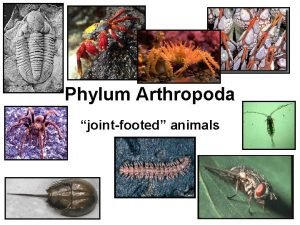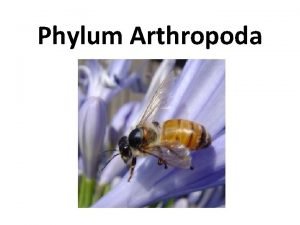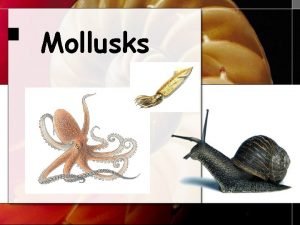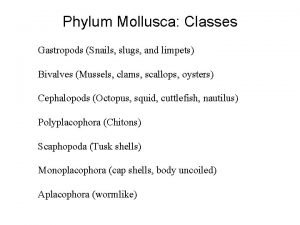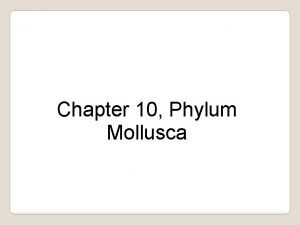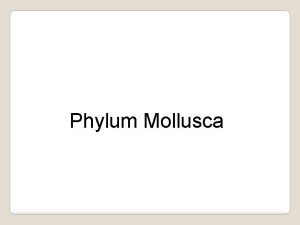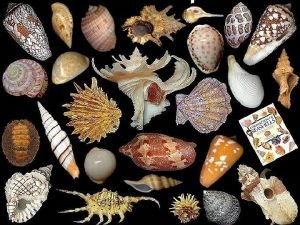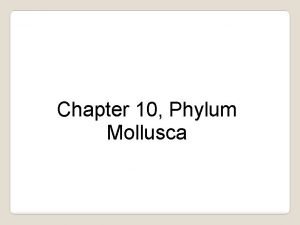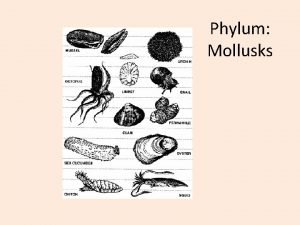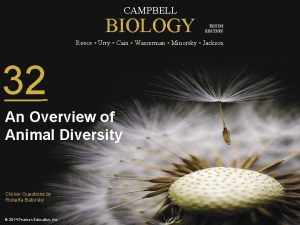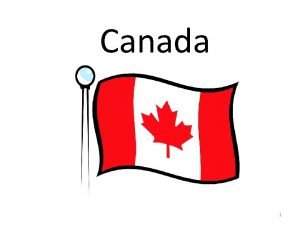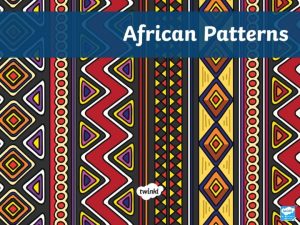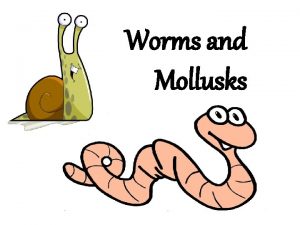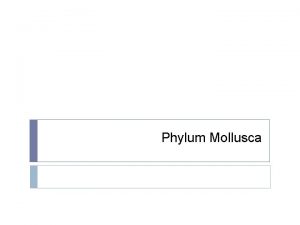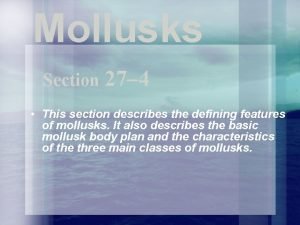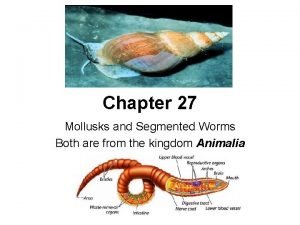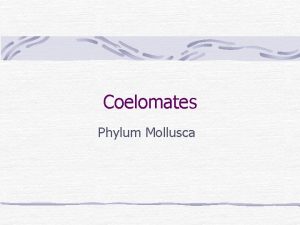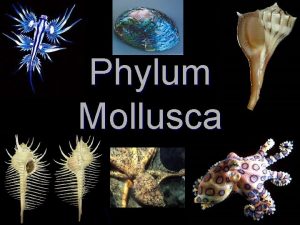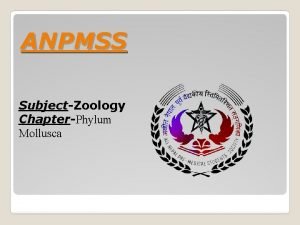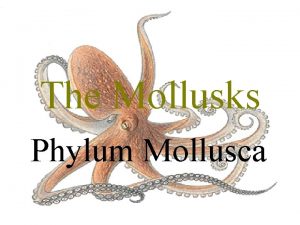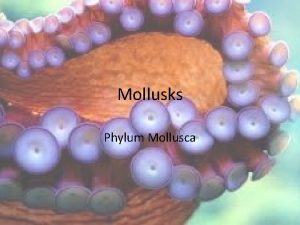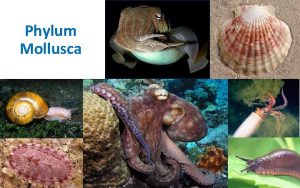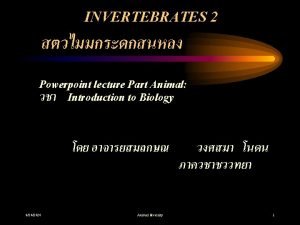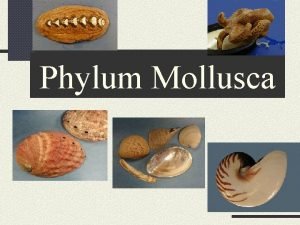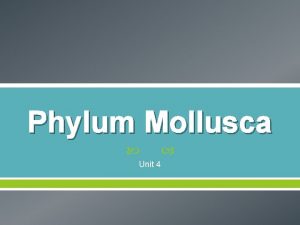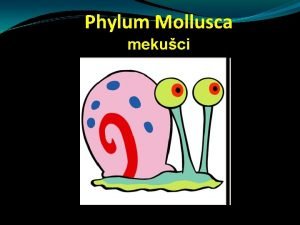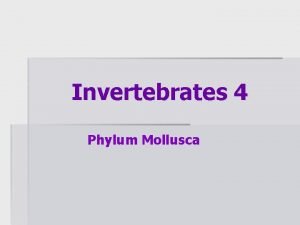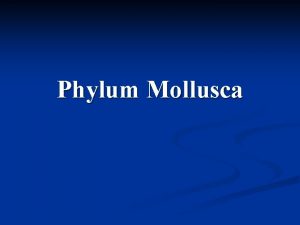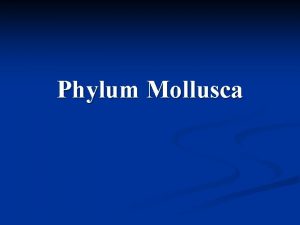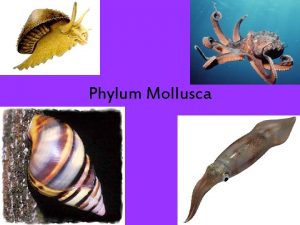Mollusks Phylum Mollusca Second largest animal phylum has






















- Slides: 22

Mollusks

Phylum Mollusca • Second largest animal phylum, has over 100, 000 species. • Live in the oceans, streams and even the treetops • Soft bodied animals with either a internal or external shell

Form and Function Basic Parts 1. Foot- Used for movement. This is used differently by different species 2. Mantle- tissue layer that covers most of the body for example in a squid 3. Shell- Made by glands in the body that secret (Ca. CO 3) calcium carbonate 4. Visceral Mass- Contains the internal organs


Feeding • Radula- thick sandpaper • Snail and slugs • Tongue like structure with 100’s of teeth • Used to bring in food or drill through shell

Feeding Continued • Snails called cone shells are carnivorous • Proboscis- an extension of the mouth. It pierces the prey, paralyzing it with venom. • Like a harpoon with a poison tip • Basically extends it mouth out to swallow prey • Has poison strong enough to kill a human if handled wrong

Feeding still Cont. • Octopi - have radula and sharp beaks - can poison their prey • Clams, Oysters, and Scallops - filter feeders - use gills and cilia to move food into the mouth

Diversity of Mollusks • You can tell that snails are very different from clams and that both differ from an octopus. • Would you classify these three mollusks in different groups? • That is what scientists do. • Each of these kinds of mollusks is a member of a different group, or class.

Gastropods (class gastropoda) • Mollusks that glide along on a foot underneath their bodies are called gastropods (GAS troh PAHDZ). • Snails, limpets, slugs, and the slug-like nudibranchs are all gastropods. • Most gastropods have one coiled shell. • The shells of limpets, however, are flattened cones. • Slugs and nudibranchs have no shell at all.

• When you watch a snail moving on the ground, you might think it is scooting on its stomach. • Actually, a gastropod's muscular foot spreads out under its body and is separate from the stomach. • A rippling motion of the foot muscle moves the snail along.

• Many gastropods eat plants and algae. • Some eat other invertebrates. • As an adaptation for getting their food, gastropods have a tongue-like organ covered with rows of teeth. • It is called a radula (RAJ 00 luh).

• A gastropod moves its radula back, and forth to scrape off and scoop up food. • Gastropods that live in water have respiratory organs called gills. • As water flows over the gills, oxygen is extracted. • Gastropods living on land have evolved a cavity inside their Bodies that serves as a simple lung.

Bivalves • Mollusks with two shells hinged together make up a second class called the bivalves (BYvalvz). • Clams, oysters, mussels, and scallops are all bivalves. • Like gastropods, bivalves have a muscular foot. • It is normally hidden inside the two shells. • Some bivalves move by hooking the foot in sand, and then pulling themselves along.

Bivalves have no head, and most move very little. Some remain attached to one place. Movement isn't important because they are filter feeders. Cilia move water across the gills. Tiny food particles, such as plankton, are trapped by mucus on the gills. • Cilia push the food into the animal's mouth. • • •

Cephalopods • The octopus and squid are the major members of a third class of mollusks called cephalopods (SEF uh loh PARDZ). • In these mollusks, the foot is divided into tentacles. • The tentacles are located at the head, away from the rest of the body.

• Cephalopods are the only mollusks to have a closed circulatory system. • In a closed system, the blood stays in blood vessels.

• Modern cephalopods all evolved from now-extinct mollusks with external shells. • In the octopus, the shell has disappeared during the process of evolutionary change. • Squids have only small internal shells. • Only cephalopods called nautiluses (NAWTuh luhs uhz) still have the external shells of their ancestors.

• Cephalopods live in the oceans and most move about freely. • Unlike the filter-feeding bivalves, they are active predators. • Their tentacles are covered with suction cups for grasping prey. • The octopus lives mostly on the ocean floor, crawling around in search of prey. • Squid swim in the open water.

Class Polyplacophora • Defining characteristics • Poly means many in Latin – Shell forms as a series of 7 to 8 separate plates • Chitons Phylum Mollusca 19

Chiton Lifestyles • Found close to shore mainly in the intertidal where they live on hard substrates • Very hard to remove from a rock. If removed with knife would curl into ball to protect internal organs. • Most members are herbivores Phylum Mollusca 20

Chiton Anatomy Phylum Mollusca 21

Ingestion and Digestion • Radula is used to scrape algae from the rocks • Mouth is anterior and anus is posterior; linear digestive tract Phylum Mollusca 22
 Joint footed animals
Joint footed animals Largest phylum of animals
Largest phylum of animals Phylum of clams and octopus
Phylum of clams and octopus Classes of phylum mollusca
Classes of phylum mollusca Mollusk characteristics
Mollusk characteristics Phylum mollusca homework and study guide #1
Phylum mollusca homework and study guide #1 Characteristics of mollusca
Characteristics of mollusca Molusca
Molusca Class monoplacophora characteristics
Class monoplacophora characteristics Phylum mollusca characteristics
Phylum mollusca characteristics What are the three classes of mollusks
What are the three classes of mollusks Which animal phylum has greater complexity than urochordata
Which animal phylum has greater complexity than urochordata Is canada the second largest country
Is canada the second largest country Is africa the second largest continent
Is africa the second largest continent Second biggest
Second biggest Akshouhini
Akshouhini Reference table periodic table
Reference table periodic table What element has the lowest electronegativity
What element has the lowest electronegativity 186 282 miles per second into meters per second
186 282 miles per second into meters per second Characteristics of worm
Characteristics of worm What is a mollusks
What is a mollusks Section 27-4 mollusks answer key
Section 27-4 mollusks answer key Chapter 27 mollusks and segmented worms answer key
Chapter 27 mollusks and segmented worms answer key
